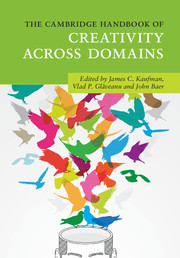Book contents
- The Cambridge Handbook of Creativity Across Domains
- The Cambridge Handbook of Creativity Across Domains
- Copyright page
- Dedication
- Contents
- Figures
- Tables
- Contributors
- Acknowledgments
- Part I Creativity and Domain
- 1 Creativity Across Different Domains
- 2 The Amusement Park Theoretical Model of Creativity
- 3 Mix and Match
- 4 Domain-General Creativity
- Part II Creativity in the Traditional Arts
- Part III Creativity in the Sciences
- Part IV Creativity in Business
- Part V Newer Domains for Creativity Research
- Part VI Creativity in Everyday Life
- Part VII Conclusion
- Index
- References
1 - Creativity Across Different Domains
An Expansive Approach
from Part I - Creativity and Domain
Published online by Cambridge University Press: 15 September 2017
- The Cambridge Handbook of Creativity Across Domains
- The Cambridge Handbook of Creativity Across Domains
- Copyright page
- Dedication
- Contents
- Figures
- Tables
- Contributors
- Acknowledgments
- Part I Creativity and Domain
- 1 Creativity Across Different Domains
- 2 The Amusement Park Theoretical Model of Creativity
- 3 Mix and Match
- 4 Domain-General Creativity
- Part II Creativity in the Traditional Arts
- Part III Creativity in the Sciences
- Part IV Creativity in Business
- Part V Newer Domains for Creativity Research
- Part VI Creativity in Everyday Life
- Part VII Conclusion
- Index
- References
Summary
Domain-generality and domain-specificity have long been debate fodder for the creativity field. As the two positions have begun to converge, the need emerges for a new reference work that both explores the general topic and offers in-depth coverage of creativity for particular domains. Our goal for this edited handbook is to offer a reference for existing research, provoke ideas for collaborations and interactions, and propel the field forward as we consider the domains that may be covered in future editions.
- Type
- Chapter
- Information
- Publisher: Cambridge University PressPrint publication year: 2017
References
- 4
- Cited by



